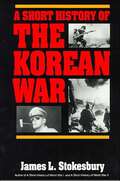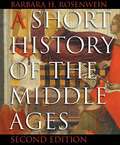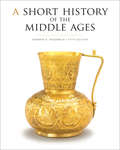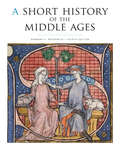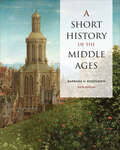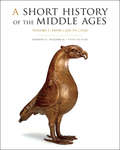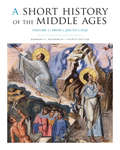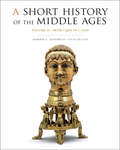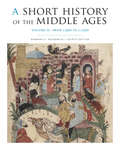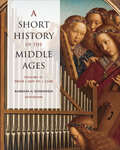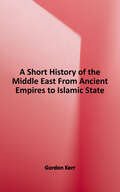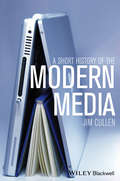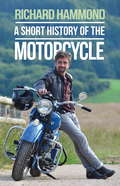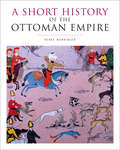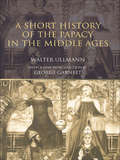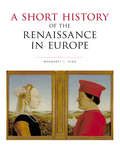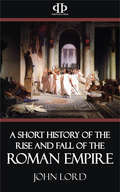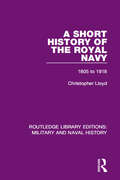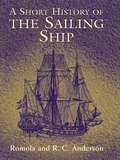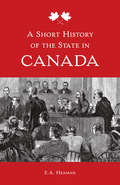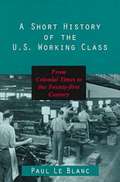- Table View
- List View
A Short History of the Korean War (Short History Ser.)
by James L. StokesburyAs pungent and concise as his short histories of both world wars, Stokesbury's survey of "the half war" takes a broad view and seems to leave nothing out but the details. The first third covers the North Korean invasion of June 1950, the Pusan perimeter crisis, MacArthur's master stroke at Inchon and the intervention by Chinese forces that November. At this point, other popular histories of the war reach the three-quarter mark, ending often with a cursory summary of the comparatively undramatic three-and-a-half years required to bring the war to its ambiguous conclusion on July 27, 1953. Stokesbury renders the latter period as interesting as the operational fireworks of the first six months: the Truman-MacArthur controversy; the political limitations on U.S. air power; the need for the Americans to fight the war as cheaply as possible, due to NATO commitments; the prolonged negotiations at Panmunjom over the prisoner-exchange issue; and the effect of the war on the home front. Whether the United States could have/should have stayed out of the war in the first place comes under discussion: "no" on both counts, according to the author.
A Short History of the Middle Ages (2nd edition)
by Barbara H. RosenweinRosenwein (history, Loyola U., Chicago) has succeeded in writing a history of the Middle Ages that presents Byzantium and Islam alongside Western Christendom with equal emphasis, developing the relationships between them throughout the text in a way students will find familiar to their own time. Though political events are described, much attention is given to developments in art and culture, religion and thought, and the realities of everyday life, making this an unusually engaging history for the beginning undergraduate. The second edition contains corrections to the first, published in 2002. Annotation ©2004 Book News, Inc., Portland, OR (booknews.com)
A Short History of the Middle Ages, Fifth Edition
by Barbara H. RosenweinIn this newest edition of her bestselling book, Barbara H. Rosenwein integrates the history of European, Byzantine, and Islamic medieval cultures—as well as their Eurasian connections—in a dynamic narrative. The text has been significantly updated to reflect growing interest in the Islamic world and Mediterranean region. Stunning plates featuring art and architecture weave together events, mentalities, and aesthetics. Medievalist Riccardo Cristiani authors a new feature on material culture that examines the intricacies of manuscript production and the lustrous glazes of Islamic ceramics. A fully revised map program offers user-friendly spot maps that clarify events right where they are discussed as well as dazzling topographical maps that reveal the very contours of the medieval world. Helpful genealogies, figures, architectural plans, and lists of key dates complement the text. All maps, genealogies, and figures are available on the History Matters website (www.utphistorymatters.com) for easy download. Students will find this site equally useful for its hundreds of study questions and their click-to-reveal answers.
A Short History of the Middle Ages, Fourth Edition
by Barbara H. RosenweinBarbara H. Rosenwein's bestselling survey text continues to stand out by integrating the history of three medieval civilizations (European, Byzantine, and Islamic) in a lively narrative that is complemented beautifully by 70 full-color plates, 46 maps, and 13 genealogies, many of them new to this edition. The fourth edition begins with an essay entitled "Why the Middle Ages Matter Today," and the book now covers East Central Europe in some depth. This edition includes three "Seeing the Middle Ages" features, each discussing a work of art in depth: An Ivory Diptych of Christ and the Virgin, Saint Luke, Gospel Book of Otto III; and A Shrine Madonna. The sections for further reading have been updated, and ancillary materials, including study questions, can be found on the History Matters website (www.utphistorymatters.com).
A Short History of the Middle Ages, Sixth Edition
by Barbara RosenweinIn this new edition of A Short History of the Middle Ages, Barbara H. Rosenwein offers a panoramic view of the medieval world from Iceland to China and from Sweden to West Africa. Yet the book never loses sight of the main contours of the period (c.300 to c.1500) or of the fate of the heirs of the Roman Empire. Its lively and informative narrative covers the major events, political and religious movements, men and women, saints and sinners, economic and cultural changes, ideals, fears, and fantasies of the period in Europe, Byzantium, and the Islamic world. A comprehensive new map program, updated for the global reach of this edition, offers a way to visualize the era’s enormous political, economic, and religious changes. Line drawings make clear archaeological finds and architectural structures All of the maps, genealogies, and figures in the book, as well as practice questions and suggested answers, are available at utphistorymatters.com,
A Short History of the Middle Ages, Volume I: From c.300 to c.1150, Fifth Edition
by Barbara H. RosenweinIn this newest edition of her bestselling book, Barbara H. Rosenwein integrates the history of European, Byzantine, and Islamic medieval cultures—as well as their Eurasian connections—in a dynamic narrative. This volume spans the period c.300 to c.1150. The text has been significantly updated to reflect growing interest in the Islamic world and Mediterranean region. Stunning plates featuring art and architecture weave together events, mentalities, and aesthetics. Medievalist Riccardo Cristiani authors a new feature on material culture that examines the intricacies of manuscript production and the lustrous glazes of Islamic ceramics. A fully revised map program offers user-friendly spot maps that clarify events right where they are discussed as well as dazzling topographical maps that reveal the very contours of the medieval world. Helpful genealogies, figures, architectural plans, and lists of key dates complement the text. All maps, genealogies, and figures are available on the History Matters website (www.utphistorymatters.com) for easy download. Students will find this site equally useful for its hundreds of study questions and their click-to-reveal answers.
A Short History of the Middle Ages, Volume I: From c.300 to c.1150, Fourth Edition
by Barbara H. RosenweinBarbara H. Rosenwein's bestselling survey text continues to stand out by integrating the history of three medieval civilizations (European, Byzantine, and Islamic) in a lively narrative that is complemented beautifully by full-color plates, maps, and genealogies. The fourth edition begins with an essay entitled "Why the Middle Ages Matter Today," and the book now covers East Central Europe in some depth. New plates have been added along with a new "Seeing the Middle Ages" feature. The sections for further reading have been updated, and ancillary materials, including study questions, can be found on the History Matters website (www.utphistorymatters.com).
A Short History of the Middle Ages, Volume I: From c.300 to c.1150, Sixth Edition
by Barbara RosenweinIn this new edition of A Short History of the Middle Ages, Barbara H. Rosenwein offers a panoramic view of the medieval world. Volume I ranges from northeastern North America to Kievan Rus’, while never losing sight of the main contours of the period c.300 to c.1150. The lively and informative narrative covers the major developments, political and religious movements, people, saints and sinners, economic and cultural changes, ideals, fears, and fantasies of the period in Europe, Byzantium, and the Islamic world. A comprehensive new map program, updated for the global reach of this edition, offers a way to visualize the era’s enormous political, economic, and religious changes. Line drawings make clear archaeological finds and architectural structures. All of the maps, genealogies, and figures in the book, as well as practice questions and suggested answers, are available at utphistorymatters.com.
A Short History of the Middle Ages, Volume II: From c.900 to c.1500, Fifth Edition
by Barbara H. RosenweinIn this newest edition of her bestselling book, Barbara H. Rosenwein integrates the history of European, Byzantine, and Islamic medieval cultures—as well as their Eurasian connections—in a dynamic narrative. This volume spans the period c.900 to c.1500. The text has been significantly updated to reflect growing interest in the Islamic world and Mediterranean region. Stunning plates featuring art and architecture weave together events, mentalities, and aesthetics. Medievalist Riccardo Cristiani authors a new feature on material culture that examines the intricacies of manuscript production and the lustrous glazes of Islamic ceramics. A fully revised map program offers user-friendly spot maps that clarify events right where they are discussed as well as dazzling topographical maps that reveal the very contours of the medieval world. Helpful genealogies, figures, architectural plans, and lists of key dates complement the text. All maps, genealogies, and figures are available on the History Matters website (www.utphistorymatters.com) for easy download. Students will find this site equally useful for its hundreds of study questions and their click-to-reveal answers.
A Short History of the Middle Ages, Volume II: From c.900 to c.1500, Fourth Edition
by Barbara H. RosenweinBarbara H. Rosenwein's bestselling survey text continues to stand out by integrating the history of three medieval civilizations (European, Byzantine, and Islamic) in a lively narrative that is complemented beautifully by full-color plates, maps, and genealogies. The fourth edition begins with an essay entitled "Why the Middle Ages Matter Today," and the book now covers East Central Europe in some depth. New plates and maps have been added along with a new "Seeing the Middle Ages" feature. The sections for further reading have been updated, and ancillary materials, including study questions, can be found on the History Matters website (www.utphistorymatters.com).
A Short History of the Middle Ages, Volume II: From c.900 to c.1500, Sixth Edition
by Barbara RosenweinIn this new edition of A Short History of the Middle Ages, Barbara H. Rosenwein offers a panoramic view of the medieval world. Volume II ranges from England to China and from West Africa to the Baltic, while never losing sight of the main contours of the period c.900 to c.1500. The lively and informative narrative covers the major developments, political and religious movements, people, saints and sinners, economic and cultural changes, ideals, fears, and fantasies of the period in Europe, Byzantium, and the Islamic world. A comprehensive new map program, updated for the global reach of this edition, offers a way to visualize the era’s enormous political, economic, and religious changes. Line drawings make clear archaeological finds and architectural structures. All of the maps, genealogies, and figures in the book, as well as practice questions and suggested answers, are available at utphistorymatters.com.
A Short History of the Middle East: From Ancient Empires to Islamic State
by Gordon KerrSituated at the crossroads of three continents, the Middle East has confounded the ambition of conquerors and peacemakers alike. Christianity, Judaism and Islam all had their genesis in the region but with them came not just civilisation and religion but also some of the great struggles of history....
A Short History of the Modern Media
by Jim CullenA Short History of the Modern Media presents a concise history of the major media of the last 150 years, including print, stage, film, radio, television, sound recording, and the Internet.Offers a compact, teaching-friendly presentation of the history of mass mediaFeatures a discussion of works in popular culture that are well-known and easily availablePresents a history of modern media that is strongly interdisciplinary in nature
A Short History of the Motorcycle
by Richard HammondIt's cold, wet and dangerous, so why do we do it? Richard Hammond's A SHORT HISTORY OF THE MOTORCYCLE attempts to explain what it is about bikes and biking that calls to some people, leaving them powerless to resist. This entertaining guide charts the history of the bike from its origins as a cheap and modest means of transport for the masses to its modern incarnations: a terrifying symbol of rebellion and menace, a high-tech racing machine and the rich kid's plaything. We look at the bikes that have propelled people across the world to work, to school and to their doom.As for the bikers ... Edwardian ladies did it, though not in large numbers. Young bucks desperate to prove their manhood did it, because it was the cheapest speed available. Hammond examines bikers of every type, from the happy farmer trundling through fields on their Honda Cub to the Hell's Angel terrorising Californian towns on their hog.Wittily written and lavishly illustrated, A SHORT HISTORY OF THE MOTORCYCLE is a thrilling ride for bikers and non-bikers alike.
A Short History of the Ottoman Empire
by Renée WorringerThe Ottoman Empire was a formidable force involved in European politics and commerce, yet it has not received its due in popular narratives of early modern history. In this beautifully illustrated overview, Renée Worringer provides a clear and comprehensive account of the Empire’s six-hundred-year history. Uncovering the strategies behind the longevity of the Ottoman Empire, the author highlights the Empire’s pragmatism and flexibility in governing over vast territories and diverse peoples. In full color throughout, A Short History of the Ottoman Empire uses clear headings, themes, text boxes, primary source translations, and maps to assist students in understanding the Empire’s complex and lengthy history.
A Short History of the Papacy in the Middle Ages
by Walter UllmannThis classic text outlines the development of the Papacy as an institution in the Middle Ages. With profound knowledge, insight and sophistication, Walter Ullmann traces the course of papal history from the late Roman Empire to its eventual decline in the Renaissance. The focus of this survey is on the institution and the idea of papacy rather than individual figures, recognizing the shaping power of the popes' roles that made them outstanding personalities. The transpersonal idea, Ullmann argues, sprang from Christianity itself and led to the Papacy as an institution sui generis.
A Short History of the Reconstruction: 1863-1877
by Eric FonerAn abridged version of Reconstruction: America's Unfinished Revolution, the definitive study of the aftermath of the Civil War, winner of the Bancroft Prize, Avery O. Craven Prize, Los Angeles Times Book Award, Francis Parkman Prize, and Lionel Trilling Prize.
A Short History of the Renaissance in Europe
by Margaret L. KingWriting about the Renaissance can be a daunting task. Not only do scholars disagree on what the Renaissance is, but they also disagree on whether or not it even took place. Margaret L. King's richly illustrated social history of the Renaissance succeeds as a trusted resource, introducing readers to Europe between 1300–1700, as well as to the problems of cultural renewal. A Short History of the Renaissance in Europe includes a detailed discussion of Burckhardt as well as new content on European contact with the Islamic world. This new edition also provides improved coverage of the Protestant and Catholic Reformations. "Focus" features provide fascinating insights into the Renaissance era, and "Voices" sections introduce a wealth of primary sources. King's engaging narrative is enhanced by over 100 images, statistical tables, timelines, a glossary, and suggested readings.
A Short History of the Rise and Fall of the Roman Empire
by John LordThe assassination of Cæsar was not immediately followed with the convulsions which we should naturally expect. The people were weary of war, and sighed for repose, and, moreover, were comparatively indifferent on whom the government fell, since their liberties were hopelessly prostrated. Only one thing was certain, that power would be usurped by some one, and most probably by the great chieftains who represented Cæsar's interests...
A Short History of the Royal Navy: 1805-1918 (Routledge Library Editions: Military and Naval History #18)
by Christopher LloydNaval histories often stop short at the death of Nelson. This book succinctly fills the gap by covering the golden age of British sea power – the period which saw the defeat of Napoleon, the American War, the expansion of the empire, the introduction of the steamship and the defeat of the first German menace. Not only a galaxy of heroic episodes, this book also highlights the relationship between the Navy in war and peace to the nation as a whole.
A Short History of the Sailing Ship
by R. C. Anderson Romola AndersonThis outstanding, amply illustrated book traces the evolution of the sailing ship from ancient times to the end of the 19th century. Extremely well-written in clear, non-technical language, the work provides detailed coverage of the ships of ancient Egypt and Crete (4000-1000 B.C.); Phoenician, Greek, and Roman ships; ships of the Middle Ages; as well as double-ended and one-masted ships. Following the main streams of development of both northern and southern European vessels, the authors elucidate the technical and cultural factors behind their change in form and function and their culmination in the full-rigged clipper ships of the 19th century. No concise history of sail has ever presented the subject more authoritatively or enjoyably as this critically praised book. Anyone with an interest in sailing ships, scholar or layman, will find the book invaluable and appealing.
A Short History of the State in Canada
by E. A. HeamanA concise, elegant survey of a complex aspect of Canadian history, A Short History of the State in Canada examines the theory and reality of governance within Canada's distinctive political heritage: a combination of Indigenous, French, and British traditions, American statism and anti-statism, and diverse, practical experiments and experiences.E.A. Heaman takes the reader through the development of the state in both principle and practice, examining Indigenous forms of government before European contact; the interplay of French and British colonial institutions before and after the Conquest of New France; the creation of the nineteenth-century liberal state; and, finally, the rise and reconstitution of the modern social welfare state. Moving beyond the history of institutions to include the development of political cultures and social politics, A Short History of the State in Canada is a valuable introduction to the topic for political scientists, historians, and anyone interested in Canada's past and present.
A Short History of the Steam Engine (Routledge Revivals)
by H. W DickinsonFirst published in 1938, this volume details the steam engine as the most dynamic factor in the Industrial Revolution, freeing humanity from their age-long dependence upon the power of water, wind, and animals, or of their own muscles. Itself the offspring of coal and iron, it made possible the sinking of deeper mines and the casting and forging of greater quantities of iron, from which machines were constructed to be powered by steam in the factories of the rapidly growing industrial areas. Soon the mass-produced goods from these mills were transported by steam locomotives and steamships all over the world. This was the Age of Steam. Even today, steam turbines still drive the dynamos of our electric power stations, whether fuelled by coal, oil or nuclear energy. Much has been written about the steam engine, but this book, first produced by the late Dr. H.W. Dickinson just before the second World War, is still the best short account. It describes developments from the pioneering efforts of Savery and Newcomen, through the achievements of Watt and Trevethick, down to Parsons and modern times.
A Short History of the Twentieth Century
by John LukacsThe historian John Lukacs offers a concise history of the twentieth century--its two world wars and cold war, its nations and leaders. The great themes woven through this spirited narrative are inseparable from the authors own intellectual preoccupations: the fading of liberalism, the rise of populism and nationalism, the achievements and dangers of technology, and the continuing democratization of the globe. The historical twentieth century began with the First World War in 1914 and ended seventy-five years later with the collapse of the Soviet Empire in 1989. The short century saw the end of European dominance and the rise of American power and influence throughout the world. The twentieth century was an American century--perhaps "the" American century. Lukacs explores in detail the phenomenon of national socialism (national socialist parties, he reminds us, have outlived the century), Hitlers sole responsibility for the Second World War, and the crucial roles played by his determined opponents Churchill and Roosevelt. Between 1939 and 1942 Germany came closer to winning than many people suppose. Lukacs casts a hard eye at the consequences of the Second World War--the often misunderstood Soviet-American cold war--and at the shifting social and political developments in the Far and Middle East and elsewhere. In an eloquent closing meditation on the passing of the twentieth century, he reflects on the advance of democracy throughout the world and the limitations of human knowledge.
A Short History of the U.S. Working Class: From Colonial Times to the Twenty-First Century
by Paul Le BlancThe book covers the vast contrast of working class that have been striving to build the country over the years - from rich elite to "middle income" and those still living below poverty line.
